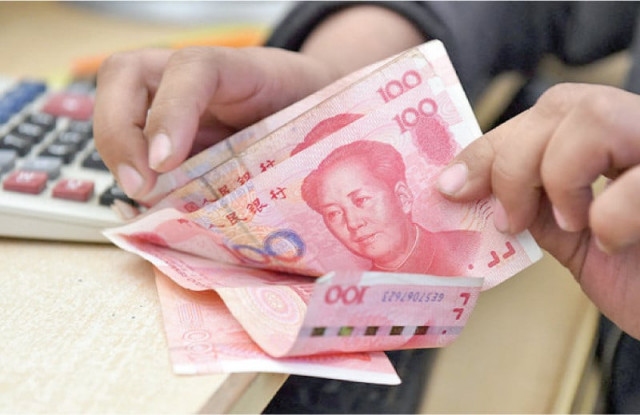$600m loan linked to IPP debt
Chinese officials say working to accomplish task, no conditions attached

Two Chinese commercial banks have linked their $600 million loans with the prior settlement of the debt that Pakistan owes to the Chinese power plants—a condition that Islamabad has refused to accept because of its implications on the budget and setting a wrong precedent.
Government sources told The Express Tribune that the prospects of securing the $600 million Chinese commercial lending have dimmed due to the fresh condition. Pakistan will take a condition-free Chinese commercial loan, they added.
Pakistan was in negotiations with the Industrial and Commercial Bank of China (ICBC) and the Bank of China for a total loan of $600 million. Each bank had been approached for $300 million in financing. Pakistan authorities had hoped that they would get the loans in December. Ministry of Finance spokesman Qamar Abbasi did not respond to questions sent to him. But a senior finance ministry official said that the government would not accept Chinese conditions, which were unprecedented given the nature of the lending instrument.
In recent years, China has helped Pakistan avoid default. But the Chinese are also frustrated over the lack of implementation of agreements signed under the umbrella of the China-Pakistan Economic Corridor (CPEC). The power plants had been established under the CPEC framework.
The Chinese have been extending loans from SAFE deposits, concessionary loans, and commercial loans to help Pakistan stabilise its external sector. In June last year, China helped Pakistan avoid a further fall in its critically low foreign currency reserves by prematurely adjusting the repayment of $1.3 billion.
The sources said that both the commercial banks have linked their loans with the outstanding payment to the Chinese Independent Power Producers (IPPs). Chinese banks have told Pakistan that they would provide a list of outstanding dues and the $600 million would be disbursed subject to the settlement of their debts.
Under the Energy Framework Agreement of the CPEC, Pakistan had committed to setting up a revolving fund and depositing an amount equal to 21% of the invoices generated for power payments. The 21% is the sum that the Pakistani authorities fail to collect, adding to the vicious power sector circular debt. The arrangement had been sought to protect Chinese firms from circular debt.
But instead of setting up a fund, Pakistan in October 2022 opened a Pakistan Energy Revolving Account (PERA) at the State Bank of Pakistan with Rs48 billion in annual allocations with a condition to withdraw a maximum of Rs4 billion per month. As a result, the Chinese IPPs’ debt is now hovering around Rs400 billion.
The government sources said that the Chinese condition about settling the IPP debt came at a later stage, as both sides had already agreed to the terms of the loans. Unlike the past, this time, Beijing had decided to give the $300 million equal to Chinese RMB. The Bank of China had offered to disburse the loan from abroad. The ICBC had planned to disburse funds from within Pakistan.
The sources said that the interest rate on the new commercial facility was agreed at 6%, but ICBC wanted to charge an additional 2.5% to offset the impact of a withholding tax.
Read $600m commercial loan linked to IPP debt
The government has informed the International Monetary Fund that its $6.5 billion borrowing plan hinges on macroeconomic conditions. Pakistan has budgeted $4.5 billion in foreign commercial loans, but it has so far not received any financing due to poor credit ratings, high risks to debt sustainability, and a weak macroeconomic situation.
The sources said that the finance ministry was of the view that Chinese commercial lending cannot be attached to any condition; as such conditions are acceptable only in case of programme loans. The interest rates for commercial lending are relatively higher than programme loans.
The government also does not have a budget allocation to clear the Chinese IPPs debt and cannot issue a supplementary grant due to the condition imposed by the IMF. There were also concerns that the federal cabinet may not approve the conditional foreign commercial loan.
When contacted, however, Chinese officials stated that the Chinese side, in collaboration with Pakistani colleagues, is diligently working to accomplish the task promptly. However, they emphasised that it is not accurate to claim that Chinese commercial banks have imposed a condition for providing loans contingent on the settlement of Chinese IPPs debts by Pakistan.
Since 2017, larger proportions of Chinese development finance have been rescue loans, rather than for developmental projects, which were the hallmark of CPEC in its heyday from 2014 to 2017 when fresh commitments were forthcoming in large amounts, wrote AidData, a western research lab, in its latest report.
Three international credit rating agencies have downgraded Pakistan, which has increased its cost of borrowing and created obstacles in the way of arranging new foreign commercial loans. Pakistan had also budgeted $1.5 billion in Eurobonds, but last month the interim Finance Minister Dr Shamshad Akhtar shelved the plan.
The senior finance ministry official said that the foreign exchange reserves have started increasing on the back of recent loans by the Asian Infrastructure Investment Bank, the World Bank, and the Asian Development Bank. They said that the central bank has also purchased dollars from the open market. As a result, the official foreign exchange reserves stand over $8.2 billion, and the IMF board is also expected to approve a $700 million tranche this Thursday. The local currency rate has appreciated in recent months despite huge purchases of foreign currency by the central bank and a relatively thin level of foreign exchange reserves. The rupee-dollar parity remained slightly over Rs281 to a dollar on Monday.
Published in The Express Tribune, January 10th, 2024.
Like Business on Facebook, follow @TribuneBiz on Twitter to stay informed and join in the conversation.



















COMMENTS
Comments are moderated and generally will be posted if they are on-topic and not abusive.
For more information, please see our Comments FAQ